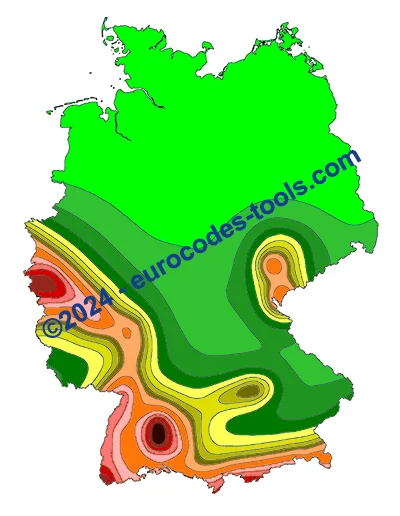
What are the German seismic zones according to Eurocode 8 (DIN EN 1998-1/NA)?
In Germany, the division is specified in the national annex to Eurocode 8 (the map below was created from this data).
Germany is divided into fifteen seismic zones.
| Seismicity SaP,R | ≤0.1 | ≤0.2 | ≤0.3 | ≤0.4 | ≤0.5 | ≤0.6 | ≤0.7 | ≤0.8 | ≤1.0 | ≤1.3 | ≤1.6 | ≤2.0 | ≤2.5 | ≤3.0 | ≤4.0 |
| Seismicity agr | ≤0.04 | ≤0.08 | ≤0.12 | ≤0.16 | ≤0.20 | ≤0.24 | ≤0.28 | ≤0.32 | ≤0.40 | ≤0.52 | ≤0.64 | ≤0.80 | ≤1.00 | ≤1.20 | ≤1.60 |

Is my new building affected?
In the German rules, areas considered to be very low seismicity zones are those for which the product agS (where ag = γI. agr is no greater than à 0.5 m/s².
You can consult the tables below to see whether your building requires an earthquake resistance check:
| Category of importance / Seismicity SaP,R | ≤0.1 | ≤0.2 | ≤0.3 | ≤0.4 | ≤0.5 | ≤0.6 | ≤0.7 | ≤0.8 | ≤1.0 | ≤1.3 | ≤1.6 | ≤2.0 | ≤2.5 | ≤3.0 | ≤4.0 |
|---|---|---|---|---|---|---|---|---|---|---|---|---|---|---|---|
| I | No | Yes | |||||||||||||
| II | No | Yes | |||||||||||||
| III | No | Yes | |||||||||||||
| IV | No | Yes |
| Category of importance / Seismicity SaP,R | ≤0.1 | ≤0.2 | ≤0.3 | ≤0.4 | ≤0.5 | ≤0.6 | ≤0.7 | ≤0.8 | ≤1.0 | ≤1.3 | ≤1.6 | ≤2.0 | ≤2.5 | ≤3.0 | ≤4.0 |
|---|---|---|---|---|---|---|---|---|---|---|---|---|---|---|---|
| I | No | Yes | |||||||||||||
| II | No | Yes | |||||||||||||
| III | No | Yes | |||||||||||||
| IV | No | Yes |
| Category of importance / Seismicity SaP,R | ≤0.1 | ≤0.2 | ≤0.3 | ≤0.4 | ≤0.5 | ≤0.6 | ≤0.7 | ≤0.8 | ≤1.0 | ≤1.3 | ≤1.6 | ≤2.0 | ≤2.5 | ≤3.0 | ≤4.0 |
|---|---|---|---|---|---|---|---|---|---|---|---|---|---|---|---|
| I | No | Yes | |||||||||||||
| II | No | Yes | |||||||||||||
| III | No | Yes | |||||||||||||
| IV | No | Yes |
The soil parameter S depends on the stratigraphic profile of the soil and the type of elastic response spectrum recommended in relation to the magnitude of the surface waves.
| Spectral acceleration SaP,R in m/s² | Soil parameters S | |||||
|---|---|---|---|---|---|---|
| A-R | B-R | C-R | B-T | C-T | C-S | |
| SaP,R ≤ 1.0 | 1.00 | 1.25 | 1.50 | 1.05 | 1.45 | 1.30 |
| 1.0 < SaP,R ≤ 2.0 | 1.00 | 1.20 | 1.30 | 1.00 | 1.25 | 1.15 |
| SaP,R > 2.0 | 1.00 | 1.20 | 1.15 | 1.00 | 1.10 | 0.95 |
Subsoil class A: unweathered, high-strength solid rock;
Subsoil class B: moderately altered solid rock or solid rock of lower strength, or coarse-grained (rolled) or mixed-grained loose rock with high friction properties in dense storage or solid consistency.
Subsoil class C: Strongly to completely weathered solid rock or loose coarse-grained (rolled) or mixed-grained rock in deposits of medium density or at least firm consistency, or loose fine-grained (cohesive) rock of at least firm consistency.
Subsoil geological class R: Rock, solid rock
Subsoil geological class T: shallow sedimentary basins and transition zones
Subsoil geological class S: deep sedimentary basins
Buildings are classified into 4 categories of importance, depending on the consequences in terms of human life in the event of collapse, the importance of the building for public safety and civil protection immediately after an earthquake, and the economic and social consequences in the event of collapse.
Each category of importance is assigned an importance coefficient γI
| Category of importance | Buildings | γ I |
|---|---|---|
| I | Buildings of minor importance for personal safety, e.g. farm buildings, etc. | 0.8 |
| II | Ordinary buildings not belonging to the other categories. | 1.0 |
| III | Buildings whose resistance to earthquakes is important given the consequences of collapse, for example: schools, meeting rooms, cultural institutions, etc. | 1.2 |
| IV | Buildings whose integrity in the event of an earthquake is of vital importance to civil protection, e.g. hospitals, fire stations, power stations, etc. | 1.4 |
Example of results for seismic zones in Germany given by Eurocodes Zoning software
The Eurocodes Zoning software allows you to obtain wind zones in Germany free of charge from a GPS point. Try it now!